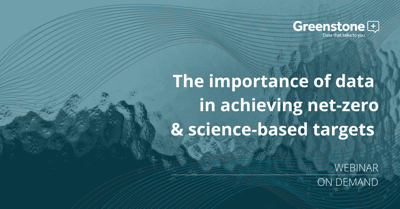COP26 and what it means for business
 From the 31st of October to the 12th November 2021, the United Kingdom and Italy will co-host the 26th UN Conference of the Parties on Climate Change (COP26) at the Scottish Event Campus (SEC) in Glasgow. Heads of state and climate scientists will gather to agree on joint steps to combat climate change. As co-host of COP26, the United Kingdom has set ambitious goals to reduce carbon emissions by 78 per cent by 2035.
From the 31st of October to the 12th November 2021, the United Kingdom and Italy will co-host the 26th UN Conference of the Parties on Climate Change (COP26) at the Scottish Event Campus (SEC) in Glasgow. Heads of state and climate scientists will gather to agree on joint steps to combat climate change. As co-host of COP26, the United Kingdom has set ambitious goals to reduce carbon emissions by 78 per cent by 2035.
In this blog, Greenstone will focus on the role of businesses and how they can actively act upon the goals set by COP26.
What is COP26?
The United Nations' COP26 event is a worldwide meeting on climate change and how nations intend to address it. Countries who signed the United Nations Framework Convention on Climate Change (UNFCCC) - a convention agreed on in 1994 - will attend the Conference of the Parties.
The COP26 conference in 2021 will be the 26th meeting, thus the name. Originally, it was expected to take place in Glasgow from November 9 to November 19, 2020, with over 200 world leaders attending, but when the coronavirus pandemic hit, there was no option but to be postponed for 2021. The most recent meeting, COP25, took place in Madrid, Spain, in November 2019 and left many major problems unsolved, although an agreement was reached on reducing carbon dioxide, a greenhouse gas that contributes to global warming. By the time of the next meeting in Glasgow, each country is expected to have committed to setting a strategy to reduce carbon emissions.
What are the main goals of COP26?
1. Secure global net-zero by mid-century and keep 1.5 degrees within reach
According to the IPCC describes net-zero is “that point when anthropogenic emissions of greenhouse gases to the atmosphere are balanced by anthropogenic removals over a specified period”. Also, the IPCC SR15 Special Report warns that the world is already 1C warmer than pre-industrial levels and that an increase to 2C would significantly worsen the risks of drought, floods, extreme heat and poverty for hundreds of millions of people.
What we see here is a commitment much anticipated and needed. Although the stakes are high, we are all hoping that this promise will be delivered.
2. Adapt to protect communities and natural habitats
COP26 action plan for this goal focuses on minimising further loss of life, livelihoods, and natural ecosystems, plans and greater funding must be put in place to strengthen early warning systems, flood defences, and construct resilient infrastructure and agriculture. Protecting and restoring ecosystems to increase resistance to the effects of climate change. Preparing an 'Adaptation Communication,' which is a summary of what they are doing and planned to do to adapt to the effects of climate change, as well as the problems they face and where they require assistance.
3. Mobilise finance
Organisations, financial institutions, banks, and investors will have to adapt in order to meet our climate targets. Countries must manage the growing effects of climate change on their citizens' lives, and they must have the resources to do so.
4. Work together to deliver
The fourth and final goal of COP26 is collaboration. A main focus for the negotiations will be to finalise the rules needed to implement the Paris Agreement, called the ‘Paris Rulebook’, and most importantly the intention to turn ambition into action.
Ways your business can act now
1. Set your science-based and net-zero targets if you haven't already.
Lead the way to a zero-carbon economy, boost innovation and drive sustainable growth by setting ambitious, science-based emissions reduction targets. If you need convincing further, a survey of SBTi companies confirms that science-based targets are not only good for the planet but are also good for business.
Furthermore, by setting a net-zero target in line with a 1.5°C future, businesses can make a critical contribution to limiting the worst impacts of climate change. ‘Business Ambition for 1.5°C’ is an urgent call to action from a global coalition of UN agencies, business and industry leaders, in partnership with the Race to Zero.
2. Align your reporting with the TCFD recommendations.
The TCFD's recommendations have had a great influence in catalysing momentum for corporate sustainability action. For the past two years, for example, Larry Fink, BlackRock’s CEO, has stipulated in his annual letter to CEOs that companies should disclose climate-related risks in line with TCFD’s recommendations.
TCFD recommends assessing potential climate-related impacts using scenario analysis, a process whereby organisations consider how the future may look if various climate pathways are realised.
3. Take the lead by going 100% renewable.
While many companies are already reducing their carbon emissions and energy bills, The Climate Group’s RE100 commitment goes a step further and signs companies up to going 100% renewable. Convened by The Climate Group in partnership with CDP, RE100 is an ambitious global initiative to engage, support and showcase influential companies committed to using 100% renewable power. In the campaign, companies gain a better understanding of the advantages of being 100% renewable and benefit from peer-to-peer learning as well as greater public recognition of their ambitions and achievements as they work towards their goals.
4. Make electric transport the new normal
It is clear that keeping global average warming below the 1.5°C thresholds will require a large shift in the way companies operate. The Climate Group’s EV100 initiative aims to transition businesses from their petrol and diesel fleets to entirely electric vehicles. Making the switch to electric vehicles is something that many companies are starting to consider. In fact, over 100 of the world's leading companies are making commitments across over 80 markets to transition their fleets to EV and install EV charging for staff and customers by 2030. This initiative is likely to gain even more support, based on the financial and environmental considerations discussed.
5. Have confidence in your GHG emissions data
With an accurate GHG emissions footprint, organisations can set reduction targets and closely monitor GHG emissions over time. Having confidence in your data is particularly important for tracking progress against science-based and net-zero targets in order to make meaningful reductions and track year-on-year progress across long-term horizons.
How Greenstone can help
Through its sustainability reporting software and supporting services, Greenstone enables its clients to accurately measure and report GHG emissions across their organisation, supply chain and investments.
Greenstone’s suite of ESG, supply chain and sustainability reporting software solutions provide integrated GHG emissions calculations in accordance with the GHG Protocol. This means that not only can all 15 scope 3 categories be tracked against long term targets in our Enterprise Environment module, but data directly gathered from suppliers and portfolio companies is converted into carbon emissions data and automatically shared across our platform to ensure the clients have an accurate and responsive scope 3 emissions inventory.
Greenstone’s sustainability reporting software includes an enhanced Targets functionality in the Environment module. Aligned with the requirements of SBTi, organisations can set and track performance against flexible and long-term environmental consumption and GHG targets. To find out more about how Greenstone’s award-winning sustainability reporting software can help you achieve your sustainability goals, please talk to us.
Resources:
HOME - UN Climate Change Conference (COP26) at the SEC – Glasgow 2021 (ukcop26.org)
(3) CBI @10am - What does COP26 mean for business? - 17 February 2021 - YouTube
COP26_Asks.pdf (wemeanbusinesscoalition.org)
On-Demand Webinar | The importance of data in achieving net-zero & science-based targets










